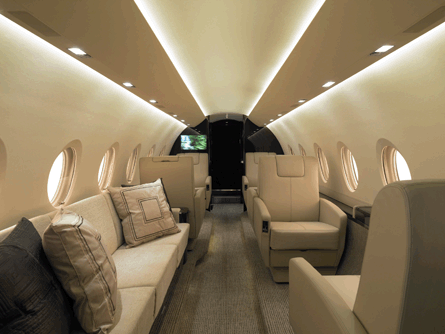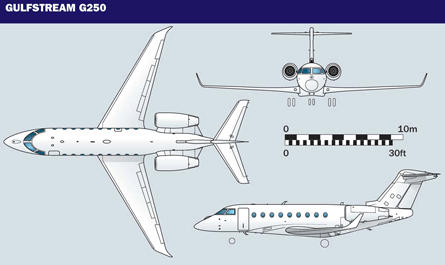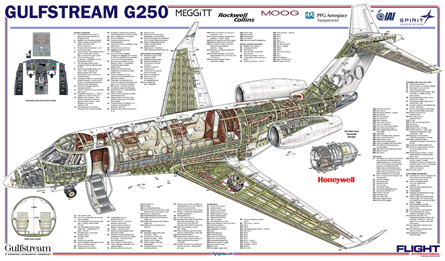In May 2005, partners Gulfstream and Israel Aerospace Industries riding high on the successful first flight of their G150 midsize jet, set to work plotting the evolution of another derivative of IAI's venerable Astra line, the G200 super midsize.
The aircraft that emerged - the G250 - has the same fuselage mould line as the G200, the twin turbofan it will ultimately replace, but "the similarity ends there", says Gulfstream mid-cabin programmes research and development director Mark Kohler.
Born of customer "desirements" and quickly evolving new technologies, the clean-sheet G250 rolled out under its own power at IAI's facilities at Ben Gurion airport near Tel Aviv on 6 October, sporting the ramp appeal of its much bigger large-cabin Gulfstream brethren.
 |
|---|
© Gulfstream/IAI |
Set for Israeli, European and US certification and service entry in 2011, the $24 million Honeywell HTF7250G-powered twinjet is the culmination of five years of design work.
Before the first metal was cut, Gulfstream hedged its bet by forming an advanced technology customer advisory team (ATCAT), composed of flight department managers, maintenance managers, pilots and cabin attendants from both the mid-cabin and large-cabin realms.
The company also put the process into action for its G650 large-cabin aircraft, set for its first flight later this year. Members must sign non-disclosure agreements to participate.
Both the G250 and the G650 will have new type certificates, the first new tickets for the line since the Gulfstream II in the early 1960s.
ATCAT's goal was to provide input on technologies, configuration concepts and validation of the designs presented by Gulfstream engineers. Once a product is announced - in October 2008 for the G250 - the ATCAT becomes the customer advisory team (CAT), a group that meets twice yearly, first focusing on the airframes and later on the cabins.
The "biggest driver" for a new mid-cabin aircraft from customers turned out to be a desire for improved balanced field length performance. "Operators wanted the ability to launch with the load of fuel needed to make the mission," says Kohler. The requirement ultimately led to the design of a new and longer wing and selection of new engines that are set to yield a take-off distance of 1,400m (4,600ft) for a 5,560km (3,000nm) trip with four passengers at M0.80. That compares to 1,830m of runway needed for the same trip for the G200 with the same payload. Customers also wanted more speed and access to the baggage area while in-flight, both characteristics of large-cabin Gulfstreams, the G350, G450, G500 and G550.
Input in hand, Gulfstream went to work developing the initial design of the wing and empennage while IAI handled the detailed design of both. Interior and completion components went to Gulfstream's mid-cabin centre of excellence in Dallas, Texas. The "green" aircraft will be assembled at IAI and flown to Dallas, where completions will take place, as is done for the G150 and G200.
 |
|---|
© Gulfstream |
What resulted from the give and take process between the companies and the CAT is an aircraft that is both outspoken and reserved on the ramp. The tail and the wing are noticeably new, but the aircraft maintains the G200's relatively low height from the ground, a nod to operators who wanted to maintain the same conspicuous presence as with the G200.
Although Gulfstream had begun the design with the heritage Astra cruciform tail, the CAT, when presented with renderings of a T-tail as an option, preferred the T, says Kohler. The choice proved wise from a performance standpoint as a fully trimmable configuration proved to offer better rotational control during take-off and less drag in cruise.
The fuselage gained four additional windows, two on each side of the fuselage, the rearmost of which on each side are used to add natural light to the lavatory in the rear of the aircraft. Windows are the same size as the G200's.
The all-new wing is fronted with a fixed polished aluminium leading edge over a bleed-air de-icing system, characteristics of the larger Gulfstreams.
Similarly, further back the wing is clean as well, with internal flap track drives and no external fairings. Flaps for the high lift system are single Fowler-style on each side powered by hydraulic actuators, features that align the G250 with the large-cabin fleet. The design, which includes new wing-to-body fairings in addition to an extra 1.5m length, provides a less complex mechanical system, better take-off performance and 23% improvement in aerodynamic efficiency at M0.80.
Longer winglets canted at a greater angle (17°) compared with the G200 add to the ramp appeal of the G250. To perfect the design, which was laid out completely in Catia 5, Gulfstream and IAI completed low-speed windtunnel testing at IAI's facilities in Israel and high-speed windtunnel testing at DNW in the Netherlands, using 1:7 and 1:14 scaled models. Kohler says additional windtunnel tests were used to decide on the larger cant angles for the winglets.
Along with the HTF7250G engines and auxiliary power unit, Honeywell is supplying the nacelles, including components of the gear box, hydraulic pump, generator and thrust reverser. The 7,445lb-thrust (33kN) FADEC-controlled turbofan generates 9% more thrust than its predecessor, the HTF7000 series engine that powers the Bombardier Challenger 300.
Unlike the G200, which has a hard-set overhaul time of 6,000h for its Pratt & Whitney Canada PW306A engines, the HTF7250G is fully MSG-3 compliant, which makes overhaul an on-condition maintenance event.
The G250 engines use generators for electrical power and air turbines for starting, tapping into bleed air either from an engine already running or from the APU, which itself is a back-up power source. The G200, by contrast, has starter-generators for power generation and starting.
 |
|---|
© Gulfstream |
Honeywell also builds the cabin pressure control system, which holds the cabin altitude at 7,000ft at a cruise altitude of 45,000ft, down 1,000ft from the G200's cabin at the same altitude, again an attempt at achieving the comfort level in larger Gulfstream cabins. Maximum certificated altitude for both the G200 and G250 is 45,000ft.
Engineers considered a full fly-by-wire control system initially, but decided such a design would unnecessarily increase complexity. Rather, a dual rudder-by-wire and a spoiler-by-wire system were included, with pitch control handled by more traditional hydraulically powered elevators and roll control by manual ailerons with spoiler assist.
A key strike against using fly-by-wire for the ailerons was the engine rotor burst failure case, which because of the 31° leading edge sweep of the wings, put the actuators in a position where one fragment could have disabled the primary and back-up systems as laid out.
"We elected to design for simplicity instead," says John O'Meara, director of flight operations and chief test pilot for Gulfstream. As a back-up to the manual aileron control, Gulfstream designed a new control path that allows the pilots to bank with spoilers if the control system jams. The philosophy differs from the G200, which has split controls between pilot and co-pilot and a manual T-handle that must be pulled out to gain access to the free aileron.
Moog, the supplier of the complete flight-control system, is providing actuators for rudder and elevator control as well as for the flaps. The company gained confidence in its design using test rigs in three of its locations to develop and test the individual systems.
A brake-by-wire system, supplied by Meggitt, features individual brake pad temperature and pressure monitoring and an automatic braking function with low, medium, high and rejected take-off settings, features not common on today's mid-cabin jets, says O'Meara.
Gulfstream is not baselining a tyre pressure monitor for the G250, although the company is incorporating the technology in the new G650. It is independently testing mechanical actuation and electrical components in its G250 integrated test facility in Savannah.
For the G250 flightdeck, the marching orders were to "make it look and feel like a large cabin flightdeck", says Kohler.
 |
|---|
That included bringing down features like synthetic vision systems (SVS) and enhanced vision systems (EVS) as well as head-up displays, items that are becoming commonplace on large-cabin aircraft. "There was a lot of new technology coming from smaller HUDs and EVSs that would be suitable," says Kohler. "The CAT was very supportive of the fact that this type of technology in this type of aircraft is a must in the future."
Operators equipped with EVS on HUDs can qualify for 100ft decision heights on straight-in instrument approaches, down from 200ft with unaided views. Pilots of large-cabin Gulfstreams desiring the credit are required to spend 2h in ground training and 2h in simulator training to be certificated for the lower approach minima, a regime that is likely to be carried over in the certification criteria for the G250, says O'Meara.
Gulfstream selected Rockwell Collins to provide its new Pro Line Fusion system for the integrated flightdeck, in this case called PlaneView250. To come up with the lowest cost options for the G250, however, SVS, EVS and HUDs were kept as options.
The G250 panel has three 15.3in (390mm) displays across, with two control and display units framing the throttle quadrant. The system will interface with Gulfstream's signature cursor control devices (CCD) for the large-cabin fleet, hand controllers that are mounted on the pilots' side panels. Pilots use the CCDs in part to cycle through charts on the centre display.
Currently PlaneView250 does not automatically switch to the airport diagram a certain time period after landing, as does the Honeywell PlaneView avionics system for the Gulfstream large-cabin aircraft.
On the primary flight displays, flight information can be shared 50:50 with maps and other large synoptics, now displayed for the first time on Gulfstream mid-cabin aircraft with the G250. In the centre multifunction display, flight planning on aircraft health information can be split into quarters, with EVS, if selected, showing on either a quarter or half-display. Gulfstream's large-cabin aircraft with PlaneView cockpits allow for the screen to be split in thirds.
The new flightdeck will also feature a new standby multifunction controller on the panel, which can also be used for EVS and SVS controls. The system automatically reverts to standby display in situations like an unusual attitude or loss of a display.
Gulfstream has also dedicated a quarter window of the synoptic display for ground servicing information, compiling and displaying data that allows pilots to perform a pre-flight check without opening any inspection doors, an idea first put into practice on the G550.
Rockwell Collins is testing flying Fusion in its company-owned Bombardier Challenger 601 and is also using two G250-specific avionics test rigs at its home base in Cedar Rapids, Iowa, to develop Fusion for Gulfstream, one of four airframers that have chosen Fusion for their new business jet cockpits. Bombardier, which has selected Fusion for its Global Vision cockpit upgrade for the Global Express XRS and Global 5000 is flight testing Fusion on a prototype Global Vision XRS.
Kohler says one Collins rig is used to test the current software version about to be delivered to the aircraft, while the second is used for the next load beyond. Collins continues to study the possibility of fusing synthetic vision with the EVS images in the optional HGS 6250 liquid crystal display HUD, but is also investigating combining the two sources of data on the primary flight display for future versions of PlaneView250.
Gulfstream is also providing two Fujitsu pen tablet PCs for each flightdeck. Called PlaneBook, the class 1 electronic flight bags will be used mainly for flight manuals, which will cut about 4.5kg (10lb) of weight in paper manuals that will no longer have to be carried. Provided by ADR, the tablet PCs are standard equipment on the G250 and the G650.
O'Meara says the EFBs will augment electronic checklists in PlaneView250 and will be integrated into training programmes.
PlaneView250 options, which can also be picked a la carte, include an intercontinental package that allows operators to dispatch for a transatlantic flight with a single failure. Included are two HF radios, two radar altimeters, two datalinks, two automatic direction finders, a third navigation source and a third flight management system.
Other options include predictive windshear, XM weather, a second chart server for paperless cockpit, en-route charts and a 3D FMS and a flightplan map.
Gulfstream is also bringing its large-cabin approach to cabin reliability down to its mid-class offerings with the G250, which means there is no loss of mission with a single-point failure. "Everything a passenger wants to do on a flight, they can do," says Kohler.
Interiors will come in three seating options, for eight, nine or 10 passengers.
Feedback is also coming from customers testing cabin concepts at shows. At last year's National Business Aviation Association's annual convention in Orlando, advice included ways to improve the work surface area in the galley and requests came to shrink the passenger service units to improve head height clearance when entering the cabin.
Potential customers also wanted to get rid of the scalloping often seen around windows and sidewalls of many business jets. Gulfstream also learned that the European style sterile and clean styling they had selected for the cabin demonstrator did not appeal broadly. "You can have that look, but you also need a traditional look with wood veneers," says Kohler.
Another request for an amenity that is standard with the large-cabin fleet - access to the rear baggage compartment while in flight - drove major changes to the G250 fuel system, compared with the G200 as its fuel tank was located behind the cabin. As a result, the G250's 6,620kg fuel load will be carried in the wings and centre wing box structure as well as in one forward belly and one aft-belly tank. Gulfstream says no crew action will be required to manage the fuel, which will be distributed automatically via gravity and an ejector pump system.
The lavatory will be similar to its large-cabin relatives, with a vacuum toilet on the right side and vanity on the left.
New acoustic research facilities in Savannah will also make for a quieter ride, the goal being to bring cabin noise "down to levels that are typical of a large-cabin aircraft", says Kohler. Evaluations carried out have included different types of gaspers, trading off noise for airflow pressure, and sound treatments with respect to air flow duct configuration in a simulated cabin environment.
Gulfstream is aiming to quieten the APU by minimising surge control valve operation, a modification that will cut APU noise by 10dB compared with the G200. The change will also result in a weight reduction as the APU will no longer require a silencer, says Kohler.
In early October, the first prototype aircraft, dubbed T1, was being prepared for first flight, with all required hardware and software loaded, says O'Meara. "Ground tests still have to be performed to be sure it's ready to go," he says.
The flight-test programme is expected to consume 1,300 flight hours with three aircraft including T1. IAI says the other two aircraft are at "a very advanced stage of being completed". The companies submitted the type certificate application with the Israeli airworthiness authority, which has bilateral agreements with the European Aviation Safety Agency and the US Federal Aviation Administration. Certification with all three authorities is expected in 2011 along with service entry.
IAI officials noted at the roll-out ceremony that there were nine orders for the aircraft so far, a number they consider disappointing, but one they expect to climb once the market recovery gains momentum.
Gulfstream appears to have succeeded in delivering a mid-cabin aircraft with the qualities of a large-cabin aircraft, but at much less cost. The CAT may have summed up the transformation best when taking their first look at renderings of a T-tail configuration versus the original cruciform tail, recalls Kohler. "It looks like a Gulfstream now," the CAT says.
Source: Flight International



























